Introduction
Did you know that once upon a time pineapples were a status symbol? People place great importance on strange things sometimes, but we're sure that having the best flagship matters - we're not just imagining that it's important to have two cameras, a best-in-class display and a beastly chipset caged in a metal unibody. Those are not passing fads like a modular design, right LG?
These flagships - the LG V20 and the Huawei Mate 9 - live and breathe trendy tech terms, many of which were invented by their parents to describe the cool new tech they've developed. LG pioneered some of the current trends, like dual cameras, though some of its projects prove more popular than others.

Huawei is a phone company with something to prove. Sure, Huawei, the network equipment maker, is a juggernaut. Huawei, the phone maker, isn't there yet but wants a status in the West similar to that of Samsung. This is usually the best time to buy from a company - when it's working hard to impress everyone, some of the old dogs tend to rest on their laurels (you know the ones we mean).
That's why there's hardly a chink in Huawei Mate 9's armor. The bezels of its metal unibody shrunk by 30% since its predecessor, the camera on the back stems from Huawei's new partnership with Leica. The company also whipped its in-house chipset division into shape and the Kirin 960 is the most impressive HiSilicon chip yet. Perhaps even the Snapdragon 820 isn't good enough.
The LG V20 (and V10 before it) remind us of BlackBerry - in a good way! BB itself failed to transition its business phones to the touchscreen era, but the V20 has that "no nonsense" feel to it. A MIL-STD-810G military rating, a removable battery, many first-party apps that show off the best of the hardware (the audiophile-level DACs, the high quality mics). The second screen is one of the best tools to keep you up to date on notifications.
Both flagships are fairly similar, but it should be easy to see they have a different outlook on life. You need to look only as far as their dual cameras - one is wide (135° on the V20), the other is narrow (43° 2x zoom on the Mate 9).
|
|
We won't ponder the symbolic meaning of this, we just wanted to point out that the LG V20 and Huawei Mate 9 are not as similar as they may appear initially. Different is good, but which is best?
We're also hard at work on a video version of this review - check back this web page tomorrow to watch it.
Availability, in-box goodies and price
We should note that different regions get different deals. For example, LG is packaging a premium Bang & Olufsen headset, but that's limited to certain countries. The V20 itself is not officially available in many places, most notably Europe (a region starved for a flagship phablet, after Samsung's handling of the Note5 and Note7).
Huawei packed its own headset, which feels no less premium than that from B&O. You're also getting a microUSB to USB-C adapter, so you can continue using your existing chargers and cables. And we got a bumper case, which while practical, spoils the premium vibe of the phone. Initially, the Mate 9 was not available in the US but that changed in the beginning of 2017.
Both companies are including fast chargers with their devices, we'll get to the charging details of that later.
While LG did not officially bring the V20 to Europe, many local retailers did and the pricing is a tad self-contradictory. In Europe, the V20 is in the lower regions of €600 and the Mate 9 is in the upper regions. In India, where LG does officially distribute the V20, it is cheaper again by a small margin (less than 10%). In the US, the two change places - a shiny new Huawei is $600, while the LG is a whopping $800. That's too ambitious if you ask us.
Design
Huawei took great pride in how much it managed to reduce the bezels on the Mate 9 - it fit a 5.9" screen in a footprint slightly smaller than the LG, which has a 5.7" main screen. The V20 is taller, in part due to the secondary screen above the main one, a trademark feature of the V-series.
The battery is another place where Huawei managed to make the best of available room, its flagship sports a beefy 4,000mAh battery compared to the 3,200mAh fuel tank in the LG. That said, the Mate 9 is a bit thicker and quite a bit heavier - 190g is on the upper end of acceptable for a smartphone. The V20 weighs 174g, you may not think it's much but it definitely makes a difference.
A secondary screen is not the only hereditary trait of the V-series, a dual-camera is too. LG is the one that kicked off that craze first with the V10 and then the G5, but Huawei brought a brand name to the fight - its partner, Leica. This dual cam doesn't protrude from the back as much, but it helps that the Mate 9 is thicker.




Mate 9's Leica-branded camera • It barely protrudes from the back • The LG V20 camera bump is more pronounced
The game of trump cards continues with audio, Huawei placed stereo speakers on the Mate 9, LG built 32-bit/192kHz Hi-Res audio into the V20 (with quad DACs to boot). These phones come with multiple microphones too - four for the Mate, three for the V20 (but the High AOP design allows them to record very loud sounds, up to 132dB). If you go to a concert, the LG V20 is the phone you want to record audio with.
The two flagships are not done trading blows and the LG has an advantage - a MIL-STD-810G transit drop compliance ensured by siloxane-polycarbonate, which is great at absorbing impacts. It's even more impressive that LG achieved this level of toughness and still managed to provide a removable back cover (giving you full access to the battery).
Both phones positioned their fingerprint readers on the back, LG was an early mover in this design trend. It's a necessity here, there just isn't enough room on the front!
Holding out your index finger near the fingerprint reader is a good idea anyway. These are large, fairly heavy phones and you need a good grip on them. Both companies have improved the handling of their phones from their predecessors. The LG V20 is surprisingly pleasant to hold (it helps that it's thinner) and so is the Huawei Mate 9 (it's thicker, true, but the rounded back distributes this beautifully).
We have to dock a few points off the V20 score sheet for its hardware buttons. The fingerprint reader (which doubles as a power key) is nearly flush with the back and hard to find by feel. The volume rocker on the side is small and low, not the easiest control to use. Huawei did much better in this regard, with a classic power button on the side (it and the volume rocker are thicker too).
Winner: Tie. These two are too different to call a clear winner. Many remain adamant they will not buy a phone with a sealed battery, others don’t care about that. The LG V20 is more practical (removable battery, shockproof) and lighter.
That said, Huawei managed to fit a larger screen in the same footprint and people tend to think it looks more “premium.”
Screen
While Huawei has dabbled with OLED, it chose an IPS LCD for the Mate 9. The LG V20 also uses an IPS screen but both are at very different resolutions - QHD/513ppi for the V20, 1080p/373ppi for the Mate 9. We think 1080p is a bit of a stretch at 5.9", but it works out well enough (if it was an OLED, the PenTile matrix would have been an issue).
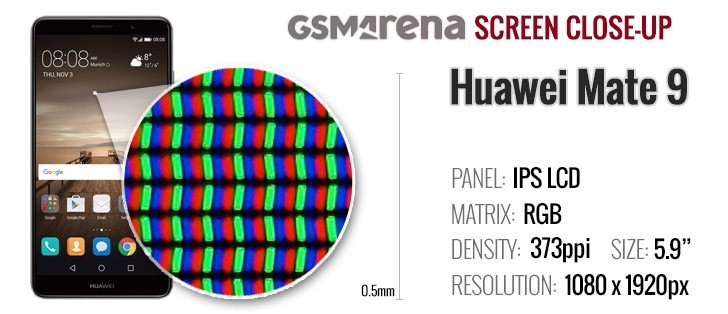
The Mate 9 screen offers superb contrast, topped by very few devices - 1,600:1, compared to LG V20's 1,100:1. The maximum brightness of both is pretty close, but the Huawei has deeper blacks. Images really pop on this display.
| Display test | 100% brightness | ||
| Black, cd/m2 | White, cd/m2 | ||
| 0.43 | 475 | 1097 | |
| 0.59 | 628 | 1064 | |
| 0.41 | 665 | 1622 | |
Both displays are hurt by the reflectivity of the glass above them - the LG V20 more than the Mate 9. So even though the sunlight numbers appear fairly close, in practice we had an easier time reading the Huawei display. Also, it gives you full control over the entire range of brightness while with the LG you get the peak brightness levels only when the Auto brightness mode decides to go into overdrive.
Sunlight contrast ratio
While contrast can make an image pop, most makers also boost the color saturation. Neither LG nor Huawei managed to calibrate their displays perfectly and they achieved average deltaE of around 5 and a maximum of around 9. The Mate 9 has a Warm mode, which drops the average a bit but despite what the mode is called, the screen maintains its blue tint.
The color accuracy is "good enough" but not terribly exciting for a flagship. Apple is pushing Wide Color Gamut displays, Samsung tried to bring HDR to mobile (with the Note7, perhaps it will have another go with the S8).
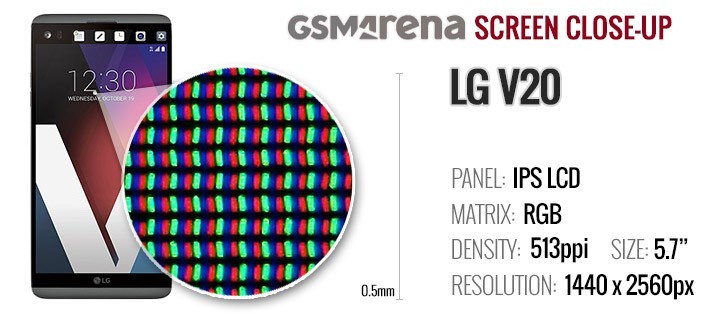
We mentioned LG V20's second screen in passing, but didn't go into details. Time to change that - the 2.1" line display has the same pixel density as the main screen but is always on. This offers at-a-glance info and instant shortcuts (no need to unlock the phone).
This display offers vital functionality when the main screen is on too - we especially like it for multitasking, it's a desktop-like feeling to tap on an app's icon and jump back to it.
Winner: Tie, again. The Huawei Mate 9 flirted with victory, its larger display offers impressive contrast ratio and better legibility in broad daylight. Still, only 1080p resolution on a 5.9” diagonal? We don’t mind it much, but at this price range we expect the best.
The LG V20 display is indeed sharper and the secondary screen is marketed as a perk. We think an Always On Display is better of at-a-glance information and the added UI features that live on the extra screen are mostly limited to LG software.
Connectivity
Both phones feature modems with blazing fast 4G LTE - up to Cat. 12 with 3 Carrier Aggregation. The LG has an extra band, AWS-3, which will enable better LTE reception in metropolitan areas in a few years' time (carriers need time to upgrade their networks). Both phones offer VoLTE for higher quality audio in calls.
They also offer fast Wi-Fi a/b/g/n/ac and Bluetooth 4.2, but only the LG has aptX. This continues the story of high-quality sound. If you use wired headphones instead, the quad-DAC (ESS ES9218) produces less noise. The LG V20 can also use USB-C headphones if you have them (you probably don't but still).
Both phones have USB-C ports, but the Huawei Mate 9 is wired only for USB 2.0 speeds. The LG V20 supports the much faster 3.0 standard, but LG didn't include the right cable for it so you'll be getting USB 2.0 speeds unless you bring your own cable.
If the head unit in your car supports MirrorLink, you can enjoy Android Auto with either phone. And they have IR blasters to control stuff at home too. That leaves one extra advantage for the LG - FM radio. Many have stopped using it, but some still turn it on daily.
Winner: LG V20. The advantages may not be immediately visible, but you may appreciate them in time. The benefits of aptX-compatible Bluetooth headphones will only work with the V20. AT&T and co. will roll out the AWS-3 sooner rather than later and you'll get better coverage. You may even get a USB-C 3.0 if you still transfer data over wires. And hey, it's better to have FM radio than not have it.
Battery life
The Huawei Mate 9 comes with the bigger battery (4,000mAh) and faster charger (22.5W). Perhaps the LG V20 will be more efficient with its hardware (3,200mAh battery, 16W charger).
That turned out not to be the case, the V20 lasted a good deal less in web browsing and video playback. The endurance rating is lower too, but we tested the worst case scenario - when the second screen never turns off. Even without that, the lower times in the two tests means the battery will deplete faster. You could, if you wanted to, carry a spare battery, though we think few will do that.
We tested Huawei's SuperCharge tech and watched the battery percentage climb quickly - from 2% to 20% in 10 minutes, to 40% in another 10 and on to 50% in another 5 minutes. You can get to 90% in an hour total, but things slow down significantly from there.
Still, that's 90% of a 4,000mAh battery. The LG V20 takes about an hour and a half to fill its battery from flat to full.
Winner: Huawei Mate 9. Faster to charge, slower to deplete is what we want to hear. You can browse the web nearly twice as long on the Mate 9 as you can with the V20, a huge difference!
Software
The LG V20 was the first phone to launch with Android 7.0 Nougat (even before the Pixels), but the Huawei Mate 9 wasn't far behind. Both companies left their mark on Nougat, but did not go overboard - the interface feels like Android with just enough maker features to assert a brand identity.
Both phones support themes, which are the easiest way to customize the look of the UI. Huawei's EMUI 5.0 has a Magazine lockscreen, meaning the wallpapers are a constant slideshow. There's an iOS-style menu with shortcuts at the bottom of the screen.
The fingerprint readers are used to secure the lockscreen as well as content. The LG V20 can only lock away files in the Gallery and QuickMemo+ apps, but on the Mate 9 you can encrypt any file with Private space and set up App Twins (great for apps that lack multi-account support).
Both companies have decided to hide the app drawer by default but they give you an option - you are a couple of clicks away from a traditional homescreen. The notification areas have brightness sliders with an Auto toggle. LG has also put in Screen and File sharing buttons here, while Huawei has kept it clean.
Since Nougat, Android has native support to block annoying notifications and filter out the low-priority ones.
Multi-window is now a stock feature in Android and it helps both phones make the best of their large screens. LG maintains QSlide, a multitasking alternative that puts apps in small floating windows, but only a handful of LG apps support this.
The LG V20 leverages its secondary screen to give you one tap access to recent apps. In some LG apps, this screen shows additional controls - e.g. playback controls in the video player, shooting modes in the camera.
Huawei didn't add any multitasking provisions beyond Nougat's Quick switch feature - double tap the app switcher to do switch to the previously used app (think alt+tab).
Android has native support for preventing apps from using background data. This saves data obviously, but can also improve battery life - without connectivity, the app goes to sleep and has no reason to wake up. Still, Huawei offers some extra tools to control an app’s power usage. This may be outside a casual user’s wheelhouse, but power users will be all over that.
LG’s gallery has extensive support for cloud storage (the music player supports the same services too!). The other media players do too.
Huawei's gallery meanwhile is simpler and the music player lacks any attention-grabbing features (though we kind of liked the lyrics everywhere option - in the player, in the notification area even on the homescreen).
Like the music player, the sound recorder on the LG V20 is designed to make the most out of the hardware (and show it off, of course). You can record lossless sound (WAV or FLAC) and you get manual control over Gain, Low cut filter and a Limiter. Again, the three mics on the phone are good for up to 132dB - a proper rock concert - and those manual controls help you keep distortion in check.
Both phones have IR blasters on top and come with capable apps to control home equipment. We quite like the option to create an all-controlling franken-remote.



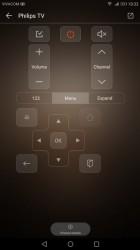
Teaching the LG V20 new IR remote functions • Building a custom remote • Mate 9 has IR prowess as well
Winner: Huawei Mate 9 (by a hair). Many of the new features on both phones are actually Android 7.0 Nougat features, but Huawei has some extra add-ons that provide value without being obtrusive (like the App Twins feature). The faster fingerprint reader (which gets more use thanks to Private space) was another consideration.
However, outside of setting menus, the LG V20 app package feels richer - quality apps that will be hard to replace with what’s in the Play Store, so no bloat. That’s nice, but we felt it fell short of achieving a tie.
Loudspeaker
The Huawei Mate 9 has stereo speakers, but that requires some explaining. This only works in landscape mode as the earpiece kicks in as the second speaker (the main speaker is on the bottom). The earpiece is quieter, but it's enough to create some nice stereo separation. The sound is nice and clean, even at high volume. And we do mean HIGH - the Mate 9 scored a rare Excellent mark!
Just keep in mind that when you switch between landscape and portrait mode there's a gap in audio.
The LG V20 has a single bottom-firing loudspeaker, which earned it a Good mark. There's no distortion, but the volume is not even across frequencies - vocals are much more quiet than high-frequency sounds.
| Speakerphone test | Voice, dB | Ringing | Overall score | |
| 68.2 | 68.6 | 80.9 | Good | |
| 83.1 | 74.5 | 85.0 | Excellent |
Winner: Huawei Mate 9. Huawei found a way to offer stereo sound even though the phone isn't specifically built for it - and it's LOUD! We hope other makers take note.
Music player and audio quality
The LG music player supports lossless audio (both FLAC and ALAC) up to 24-bit 192kHz. You can toggle the quad-DACs on and off to hear the difference as well as play with the equalizer. There’s a preset for LG’s own QuadBeat headset, but not for the B&O one that came with the V20.
The LG V20 and Huawei Mate 9 were closely matched in terms of clarity. They were perfect with an active external amplifier, while headphones caused moderate damage to their stereo quality, but no issues elsewhere.
The V20 had a clear advantage in terms of loudness though and that spanned both test cases. While the Mate 9 was just above average, the LG flagship was excellent and among the louder we’ve seen. .
| Test | Frequency response | Noise level | Dynamic range | THD | IMD + Noise | Stereo crosstalk |
| +0.03, -0.01 | -92.2 | 93.0 | 0.0026 | 0.0093 | -93.3 | |
| +0.06, -0.05 | -91.1 | 91.8 | 0.016 | 0.056 | -63.5 | |
| LG V20 | +0.01, -0.03 | -93.0 | 93.1 | 0.0036 | 0.0075 | -93.7 |
| LG V20 (headphones attached) | +0.04, -0.09 | -92.4 | 92.4 | 0.051 | 0.105 | -57.5 |

Winner: LG V20 - the clarity is on par, but the higher loudness wins this round for LG.
Performance
Smartphone makers learned a hard lesson when Qualcomm dropped the ball with the Snapdragon 810. Companies like Huawei and Samsung have their own chips to fall back on while LG seems in development of a chip to power its flagships, none has materialized yet.
The Kirin 960 chipset inside the Huawei Mate 9 is built on ARM tech, the latest generation. This means Cortex-A73 processor cores (four for the big cluster) and Mali-G71 GPU (the first to use the new Bifrost architecture).
The Snapdragon 820 is custom Qualcomm tech - from the Kryo cores (2+2) to the Adreno 530 GPU. Adrenos are usually the best GPU's this side of the Apple/Android divide so Snapdragons are great chips for gaming. But first things first.

AnTuTu 6 and Basemark OS 2.0 fail to give a definitive answer on which phone is faster for general use. Both phones have 4GB of RAM and up to 64GB of fast UFS 2.1 storage so opening apps and switching between them is a breeze.
AnTuTu 6
Higher is better
Basemark OS 2.0
Higher is better
Digging in deeper, it seems that a Cortex-A73 core outpaces a Kryo core. It helps that they are clocked higher (2.4GHz vs. 2.15GHz) even though Qualcomm fabbed the chips on Samsung's 14nm FinFET process. Samsung managed to get its own Mongoose core up to 2.3GHz on this process. The Kirin is born out of 16nm TSMC FinFETs (used by Nvidia and AMD for their latest GPUs).
GeekBench 4 (single-core)
Higher is better
It should come as no surprise then that the multi-core performance swings heavily in favor of the Huawei Mate 9. Individual cores are faster and there are more of them, seems like a no-brainer.
GeekBench 4 (multi-core)
Higher is better
Let's move on to gaming and split it into two parts. Starting with raw power, the LG V20 and its Adreno 530 GPU has a 30% to 50% lead on its opponent. This, however, assumes that the games renders at 1080p instead of the native QHD resolution (which many games do).
GFX 3.0 Manhattan (1080p offscreen)
Higher is better
GFX 3.1 Manhattan (1080p offscreen)
Higher is better
GFX 3.1 Car scene (offscreen)
Higher is better
If a game chooses to go to native resolution, then the Huawei Mate 9 comes out on top with a 15% to 35% margin. So it depends on what a game developer wants to cut to hit the target frame rate - resolution or graphics fidelity.
GFX 3.0 Manhattan (onscreen)
Higher is better
GFX 3.1 Manhattan (onscreen)
Higher is better
GFX 3.1 Car scene (onscreen)
Higher is better
Basemark X
Higher is better
Basemark ES 3.1 / Metal
Higher is better
While we're at it, we tested the storage of both phones. In theory, we should get near identical performance - both use UFS 2.0 storage. In practice, the LG V20 shines with a faster random write speed (important for app performance). It does lose the sequential read battle to the Huawei Mate 9, but we think this will have less of an impact on the daily performance of the phone.
Androbench
Higher is better
Winner: Huawei Mate 9. Huawei chose the right chip for the job, the processor is plenty fast and the GPU is a great match for the 1080p screen. The LG V20 could have leveraged its more powerful GPU if LG gave users the option to reduce the screen resolution like Samsung does. Its storage is faster where it counts, though.
Camera
Huawei partnered with legendary camera maker Leica and the Mate 9 is armed with the second generation product of their collaboration. It's built around two cameras - one with a 12MP color sensor and one with a 20MP monochrome sensor.
The phone can mix the imagery from both cameras in various ways, creating some advanced functionality. The most basic thing is the zoom - we got some impressive results at 2x zoom (54mm-equiv. FoV). The slider goes up to 6x though the quality degrades quickly past the 2x mark.
LG went the other way - V20's second camera is used to offer a wider view of the scene, essentially zooming out from 75° to 135° FoV. It's debatable whether zooming in or out is more useful. However, that second camera on the V20 has only an 8MP sensor and fixed focus.
That means it can't really augment the main camera like the Huawei Mate 9 can do. Other dual-camera tricks it does is Google Pixel-like HDR+ (super sampling instead of multi-exposure) and Wide aperture - you can create soft bokehs with a simulated aperture of f/0.95 or go all the way to f/16 to have everything in sharp focus.
And, of course, the Black & White camera on the Mate 9 is more sensitive in low light, but we're getting ahead of ourselves. We start shooting samples during the day and then we'll move on to the night shots.
The Huawei Mate 9 has the option to shoot color photos in either 12MP or 20MP resolutions. How when the color camera is only 12MP? The human eye has more rods (which see in black and white) than cones (which give us color vision) so Huawei can do this with no visible degradation of image quality. In fact, this is one of the basic ways to compress images and video (it's called "chroma subsampling").
The 12MP camera on the Mate 9 struggles with the finer detail that LG V20's 16MP camera can resolve. Even with the 20MP camera in play it still lags behind. The 20MP mode does improve the image quality, but the 20MP monochrome mode is even sharper. We noticed that the Mate 9 is susceptible to moire effects (easy to see in the second sample), which carry over to the 20MP image as well (moire is caused when there's not enough resolution to capture the minute details). That said, it handles foliage better - the LG has a tendency to paint plants in an unnatural uniform color, while the Huawei captures their beauty more faithfully.
The LG V20 has a color spectrum sensor, but it never got the white balance quite right. The Huawei Mate 9 camera offers the "Leica look" and while we detect some sharpening and a slight saturation boost (things Leica is against), the end result is quite pleasing.
The V20 always tries to preserve the highlights, which is good sometimes and bad other times. As the V20 camera tries to rescue the highlights, it often gives them a tint of color which can look off - just look at the snow, we prefer the overexposed-but-white snow of the Huawei over the yellowish snow of the LG.
We mentioned that the Mate 9 has a dedicated night mode, but that one requires a tripod - it does multiple exposures and the OIS wasn't enough to counteract camera shake (you can push exposure time all the way up to 32s with a tripod). So anyway, we stuck to the normal mode.
Both phones have OIS, though the LG V20 did a better job. We had to pick through multiple Mate 9 samples that had clear handshake. Not that the V20 is perfect, its most common mistake was missed focus. Sure, it has Laser autofocus, but that works only up to 1.5m (6ft), so it's no good for landscape shots. The LG V20 was also slower in capturing and saving photos.
It was worth the wait, though, LG has found a good balance between reducing noise and preserving detail. Huawei's post processing was more aggressive and on occasion smudged fairly large elements.
We took additional photos, this time including the black & white camera into the mix, thinking it will have an advantage (since color filters reduce the light reaching the sensor). As it turns out, there are no tangible benefit beyond the cool B&W look. These shots are processed differently - the contrast is boosted noticeably, making light and dark elements of the image stand out more.
Pixel peepers may want to head over to our Photo quality comparison tool to continue the evaluation of the LG V20 and the Huawei Mate 9. We included both 12MP and 20MP shots for the Huawei.
Winner: Huawei Mate 9. It offers features we'd use more often and while minute detail isn't its strong suit, the Leica-branded camera produced the more pleasing images. We prefer its color rendering, that it doesn't overexpose parts of the image off-white, it also handles variations in color hues better (most visible in plants, but elsewhere too).
The LG V20 still has one of the sharpest cameras on the market, but LG's processing keep it from shining. The wide-angle camera can be fun, but it is less useful in practice than Mate 9's second camera - the 8MP fixed focus just doesn't have the image quality. Whether you want to zoom in or out is debatable, but at least the Huawei does zoom (and bokeh) without taking a hit in quality.
Shooting RAW
Both phones have the option to save RAW data from the camera sensor and both export in the universal DNG format. We captured a few RAW+JPEG photos with the LG V20 and the Huawei Mate 9 and then imported the DNGs to a PC and edited them to suit our preference.
The results are similar for the two smartphones. If you know what you're doing shooting RAW will give you a considerable advantage. You get control over sharpness, noise reduction and saturation, among others - the three things that can make or break an image.
The LG V20, like any modern smartphone, applies noise reduction and sharpness to its images. But compared to the Mate 9 the LG V20's images are less processed from their DNG counterparts. There is less noise reduction applied here so in the scene below the LG V20 resolved more detail.

We played around with the sharpening and brightened the shadows a bit but that's it.
We wouldn't say shooting and editing RAW from the LG V20 is worth it as we didn't make a whole lot of difference to the resulting photos.
You can download and tinker with the RAW files from the LG V20 yourself to see just how much information they have - DNG 1, DNG 2.
With the Huawei Mate 9 we found RAW to be much more useful.

Like the LG, the Mate 9 also applies a lot of sharpening and noise reduction to its photos, even more so. We toned both down in the edited file (the one on the right) and also made the shadows brighter. By editing the DNGs from the Mate 9 we were able to get more detailed textures and objects and a brighter image with more detail and much nicer colors.
The better colors are most noticeable in the red and blue buildings in the far background. In the in-camera JPEGs you can't tell what color they are.
We'd say that there aren't meaningful benefits to shooting RAW on the LG V20 and there are real benefits to shooting RAW on the Huawei Mate 9. A JPEG, edited from DNG, from the Mate 9 looks much better than the in-camera JPEG and gives the Mate 9 an edge over the V20.
Selfies
The original V-phone was among the first in the new wave of dual camera phones, except unlike the 2016 models, its dual camera was on the front. The LG V20 emulates the wide and narrow FoV with a single camera which produces 5MP shots in either case.
This gives the Huawei Mate 9 a leg up on resolution, 8MP, if not field of view. Both phones have bright f/1.9 apertures for their selfie cams and can shoot 1080p video through them.
The Huawei takes a definitive victory in resolved detail, it's miles ahead of the LG (the difference is bigger than you would expect from 8MP vs. 5MP). V20's wide mode looks better than the narrow mode, but both are quite soft compared to the Mate 9 shots. Also, the background in the Mate 9 photos is slightly soft, helping the subject stand out.
When taking selfies, keep in mind that the LG V20 has a fixed focus camera and you have to hold the phone at the right distance from your face (slightly less than arm's length in our case). The Huawei Mate 9 empowered its selfie camera with autofocus, which gives you more freedom, but its range is a bit limited.
Winner: Huawei Mate 9. If you manage the right focus distance, you're in for sharp, detailed selfies. We also appreciate the autofocus (even if it wasn't the best), few makers bother even though it can make a big difference in user experience. We like LG's wide/narrow modes, but would have loved a sharp image even more.
Video recording
The video recording can be split into three categories, each with its own use. The phones top out at 2160p, which should offer the most detailed image - perfect for those large 4K TVs. Then there's 1080p @ 60fps, which captures motion smoothly (but suffers a detail penalty) and finally the classic 1080p @ 30fps mode.
The LG V20 records sharp 2160p footage, while the Huawei Mate 9 exhibits some visible compression artifacts, which hurt the perceived resolution. A quick investigation reveals that the V20 shoots at 47Mbps while the Mate 9 is at 30Mbps and it shows.
Both phones exhibit a "pulsation" in image quality. On the Mate 9, every couple of seconds an extra compressed frame appears (which looks like the noise in the image suddenly increased). On the LG V20 the compression artifacts build up until they are cleared by the next key frame and then it starts all over again.
The LG V20 captures clearer sound and you can adjust the sensitivity of the microphones - effectively "pointing" them forward towards the scene or back towards you (or any position in between). This is great if you want to narrate or let the scene play out without commentary from your group.
We also love the focus peaking when you enable manual focus - on this small screen with no eyepiece, it's vital in keeping the right things in focus.
The Huawei Mate 9 captures sound at a higher bitrate (192Kbps vs. 156Kbps) but wasn't as good at removing wind noise.
Our video comparison tool makes it easy to compare still frames at 100% magnification, here is the LG V20 vs. the Huawei Mate 9, both in 2160p mode.
The 1080p @ 60fps videos from the Mate 9 appear heavily pixelated, in practice they are closer to 720p. The LG V20 showed only a minor drop in sharpness between its two 1080p modes - 60fps and 30fps. Strangely, the Mate 9 uses a higher bitrate here than for the 2160p videos (34Mpbs), while the V20 shot at about half the bitrate (24Mbps). Huawei claims that the H.265 compression used for 2160p videos saves up to 50% bitrate compared to the older H.264 used for both 1080p modes. That may be so, but we still think a higher bitrate would have helped.
Even when we move to the basic 1080p @ 30fps, the Huawei Mate 9 lags behind in resolved detail. You can easily see LG's advantage in the trees, footsteps in the snow and even the buildings.
We shot 1080p videos for the Video quality comparison tool as well, here they are.
Both phones boast video stabilization, but the fine print says that it works only at 1080p @ 30fps. For anything above, you only have OIS to rely on.
Winner: LG V20. On all counts. The 2160p videos are only slightly better than Mate 9's, but the audio is great. The difference in quality is most evident in the 1080p @ 60fps test, we just wouldn't use the Mate 9 to shoot 60fps videos. Even 1080p @ 30fps, a mode that has been available on phones for years now, wasn't perfect on the Huawei.
Final words
They say you shouldn't judge people by the clothes they wear, is there a similar saying about smartphones? Because we think you can tell a lot about a person by phone they use. If you see someone packing an LG V20 or a Huawei Mate 9, that's clearly a person that surfs the web a lot, for example.
If we let our audiophile selves run the show, they'd pick the LG V20 - for the awesome sound quality (both playing and recording), even if we swap the B&O headphones for our own pair. The wide camera gives videos that 'action cam', though we're not sure we'd risk an expensive phone and prop it up on the handlebars of our bikes.
The secondary screen may be a defining feature of the V20, but we think it has been surpassed by Always On Displays (including LG G5's). Yes, it offers an extra place for shortcuts, not part of the regular Android UI, but it was not a killer feature for us.

We would pick the Huawei Mate 9 for its great battery life and gaming performance. A particularly powerful loudspeaker also helps and we liked the deep blacks of the screen.
The dual camera wasn't perfect (our biggest issue was with video capture), but still edged out the LG overall. We liked the high quality zoom and bokeh effect and the selfie camera trounced the V20 cam.
Here's a tip - open the battery info screen on your phone and check what used the most power. Games or the music player? How long is your screen on time? Also check your gallery, it should give you instant feedback of how many photos and videos you took over the last few days.
Well, with that in mind, which phone is for you? Despite superficial similarities, the LG V20 and Huawei Mate 9 have very different characters and would suit different people.




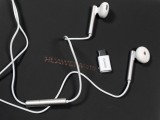
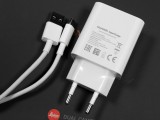
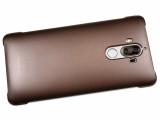



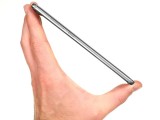









































































































Комментариев нет:
Отправить комментарий